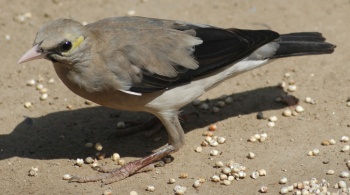- Creatophora cinerea
Identification
21cm. A medium-sized, greyish starling.
- Grey body, white rump, black flight feathers and tail
- Breeding male with white shoulder patch, unfeathered yellow skin and black forehad and throat wattles
- Non-breeding males with feathered head and a small yellow patch behind the eye, no wattles and a black moustachial stripe
Females and juveniles are similar to non-breeding males but the flight feathers and the tail are brown.
Distribution
In east Africa from Eritrea and Ethiopia south to Uganda, Rwanda, Burundi, Kenya and Tanzania. Also in southern Africa from Angola and Democratic Republic of Congo to Zambia, Malawi, Mozambique, Namibia, Botswana, Zimbabwe, Lesotho, eSwatini and South Africa.
Widespread and locally common.
Taxonomy
This is a monotypic species[1].
Habitat
Grassland, open woodland and cultivation. Generally below 2000m but recorded up to 3000m in East Africa.
Behaviour
Gregarious, often in flocks of around 30 birds, sometimes in immense flocks with thousands of birds. Associates with African Pied Starling and outside of breeding season also with Common Starling, Common Myna, Red-winged Starling, Cape Weaver, Cape Glossy-Starling, Greater Blue-eared Glossy-Starling, Chestnut Weaver, Superb Starling and sometimes Hildebrandt's Starling or Violet-backed Starling.
Diet
Feeds mainly on locusts and other insects but takes also plant matter including nectar. Often follows locust swarms.
Breeds
Breeds opportunistic, related to abundant food resources. Breeds colonial, hundreds or thousands of nests together, sometimes sharing colonies with the Cape Weaver. Both sexes make a globe shaped nest from twigs and lined with grass or feathers, which is placed in trees or bushes. 3-4 pale blue with brown spots, eggs are laid, and then the dome of the nest is finished. Both parents incubate for 11 days and feed the young which fledge after a further 13-16 days.
Movements
A highly nomadic species.
References
- Clements, J. F., T. S. Schulenberg, M. J. Iliff, S. M. Billerman, T. A. Fredericks, J. A. Gerbracht, D. Lepage, B. L. Sullivan, and C. L. Wood. 2021. The eBird/Clements checklist of Birds of the World: v2021. Downloaded from https://www.birds.cornell.edu/clementschecklist/download/
- Del Hoyo, J, A Elliott, and D Christie, eds. 2009. Handbook of the Birds of the World. Volume 14: Bush-shrikes to Old World Sparrows. Barcelona: Lynx Edicions. ISBN 978-8496553507
Recommended Citation
- BirdForum Opus contributors. (2025) Wattled Starling. In: BirdForum, the forum for wild birds and birding. Retrieved 13 May 2025 from https://www.birdforum.net/opus/Wattled_Starling
External Links
GSearch checked for 2020 platform.






